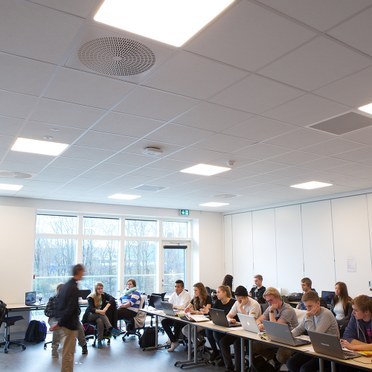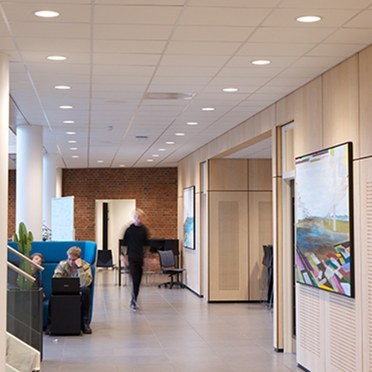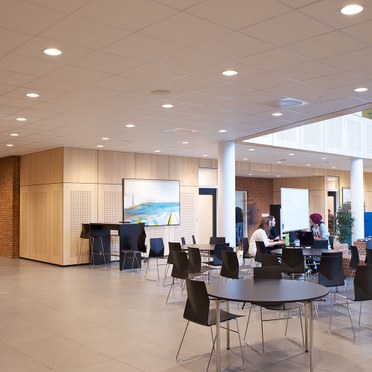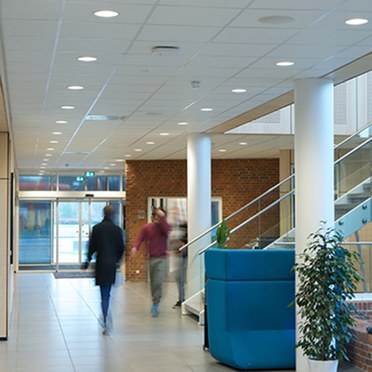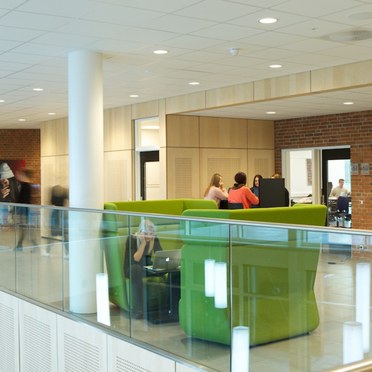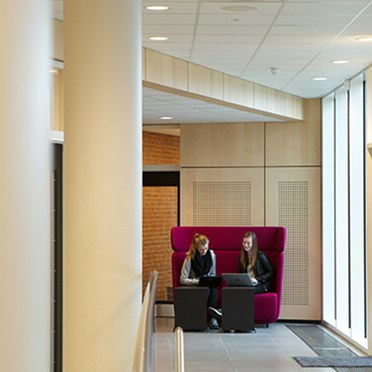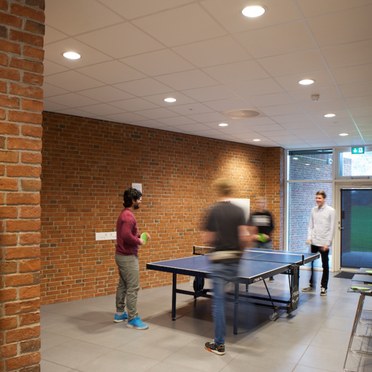Skive Business College, Denmark
- Lamp efficacy
Lamp efficacy
Ensuring the lamp efficiently converts electricity into light (lm/W).
- Ballast classification
Ballast classification
Controlling the electricity supply to the lamp (Energy Efficiency Index).
- Luminaire distribution
Luminaire distribution
Controlling light emission using optics which bend and shape the light to the correct location.
- System efficacy
System efficacy
Combining optical and thermal control within the luminaire (luminaire lm/W).
- Presence/absence detection
Presence/absence detection
Presence: Lights automatically turn on/off with movement. Absence: Lights automatically turn off and must be manually switched on.
- Daylight detection
Daylight detection
Artificial lighting which responds to the natural light conditions.
- Constant illuminance
Constant illuminance
A function designed to produce correct light levels for the duration of the maintenance period.
- Task-scene setting
Task-scene setting
Allowing the user to set scenes and adapt the lighting to different tasks.
- Timed off
Timed off
Automatic cut-off can be installed to turn all lights off during unoccupied hours.
- Task lighting
Task lighting
Lighting task areas with the correct amount of light.
- Zoning of lighting
Zoning of lighting
Lighting is zoned according to area use.
- Maintenance schedule
Maintenance schedule
Maintenance must be performed in response to product age, performance and environment.
- Waste light
Waste light
Eliminating waste light which does not hit the intended target.
- Reflectance
Reflectance
Taking advantage of light which is reflected from the surface within the space.
- Visible smart metering
Visible smart metering
Results of actions can be quickly seen as increased or decreased energy use to encourage responsible energy consumption.
Skive Business College in Skive, Denmark, is one of the most modern and dynamic schools in the country. It has worked hard in recent years to create a comfortable and effective educational environment and has most recently extended its facilities with a new wing comprising 15 new classrooms and shared facilities.
Lighting objectives
Lighting was a key consideration for the new wing. The college was keen to find a solution which would contribute positively to the various learning and recreational activities that take place during the day. The lighting had to be efficient and work well for both students and teachers, and in classrooms, hallways and the shared facilities.
Lighting solution
Skive Business College chose Thorn LED luminaires to illuminate the new wing with a combination of Omega LED fixtures in classrooms and Chalice LED fixtures in the corridors.
Results and benefits
Omega LED uses 50% less energy than a 4x18W T26 (T8) fluorescent. What’s more, with DALI dimming as standard, the college can easily make additional savings while ensuring the lighting is suitable for the task. As well as being energy efficient, Omega LED provides good glare control to eliminate uncomfortable reflections from computer screens and smart boards.
In the corridors, Chalice 190H LED luminaires create a focused and effective downward light of 2 000 lumens in areas where it is often a challenge to create good lighting conditions. Chalice 190H can reduce energy consumption by up to 70% compared to conventional CFL downlights, making it particularly suited to the college’s long burning hours.
Both luminaires are fitted with plug and play connectors, making them easy to install and replace. There are also individual classroom controls for maximum flexibility.
Niels Yde, Director at Skive Business College, is pleased with the lighting provided by the Thorn luminaires. He explains: "We looked at several factors while choosing the final lighting solution. First of all it was important for us to ensure task lighting which is well suited for educational use. It's also always a challenge to ensure the correct colour reproduction when transition from incandescent to LED. But we have successfully achieved that by working together in collaboration with the architect and the engineer on the project."
“In addition, we of course looked at efficiency. We need the lights on a lot of hours every day, so the economics of running the lighting is important – both in what it costs to have the lights on and the operational savings due to fewer lamp changes.
"All in all, we're delighted to have a college that uses the latest technology which looks great and is optimised for the demands of the future."
- Skive Business College, Denmark
(PDF/
274 KB)
Download as PDF

